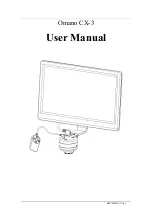
64
DISPLAYING THE MEASUREMENT RESULT
This map display facilitates qualitative comparison of aberration due to corneal topography
and aberration of total refraction.
Changing to other map: Tap the Layout Change button.
Description of Each Display
(1) Mire image
Image by projecting a Placido ring to the cornea. An image of corneal
surface; from this image, measurements related to the cornea are
analyzed. The pupil diameter is displayed together with the time and
date of measurement at the bottom part.
Operation:
• When tapped, the image is enlarged. (See "ENLARGEMENT DIS-
PLAY" on page 79.)
• When dragged in the right-left direction, the overlay can be
changed. (See page 83.)
(2) Axial Power map
A map to display the distribution of corneal refractive power.
KR values are displayed at the bottom part of the map.
Operation:
• When tapped, the map is changed to the cornea aberration map.
(See page 67.)
• The map scale can be changed. (See page 130.)
(3) Corneal HOA map A map to display corneal higher order aberrations (e.g. irregular
astigma). At the bottom part of the map, corneal higher order aberra-
tion, 4-mm area and 6-mm area, are displayed with RMS values.
Operation:
• When tapped, the map is changed to the cornea aberration map.
(See page 72.)
• The map display step can be changed. (See "Setting the Display
Step of High Order Aberration Astigma Map" on page 129.)
(4) Hartmann image
A point image reflected from the internal ocular part through the
pupil. From this image, REF values, ocular total aberration, high
order aberrations, etc. are calculated. Description about the analysis
is given at the bottom part of the image. (Analysis center/Amount of
central movement (see page 88))
Operation:
• When tapped, the image is enlarged. (See "ENLARGEMENT DIS-
PLAY" on page 79.)
• When dragged in the right-left direction, the overlay can be
changed. (See page 83.)
(5) Ocular Total Aberration map
A total aberration map, including lower order aberration of ocular
refraction. This map can distinguish near and far vision tendencies.
REF values are displayed at the bottom of the map.
For example, if the center of the map is cold in color (blue), near
vision tendency. If the center of the map is warm in color (red), far
vision tendency.
Summary of Contents for KR-1W
Page 1: ...INSTRUCTION MANUAL WAVE FRONT ANALYZER KR 1W ...
Page 2: ......
Page 186: ......
Page 188: ...KR 1W WAVE FRONT ANALYZER 41835 97992 Printed in Japan 2010 02 100LW2 ...
















































